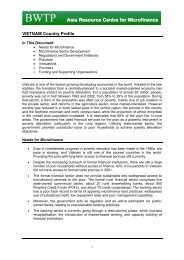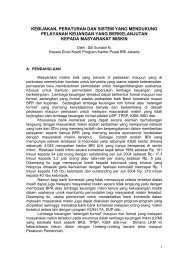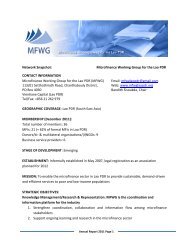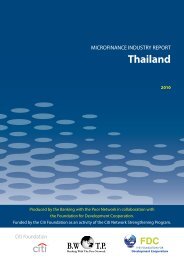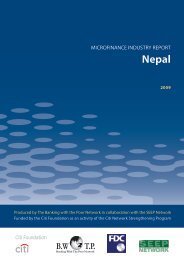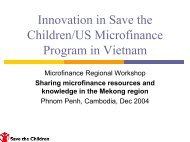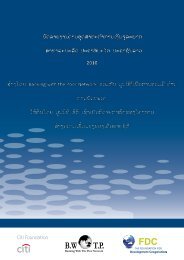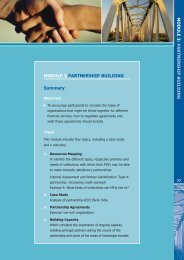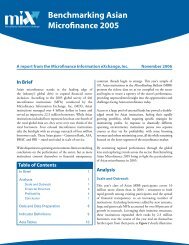Microfinance Industry Report: Indonesia - Banking with the Poor ...
Microfinance Industry Report: Indonesia - Banking with the Poor ...
Microfinance Industry Report: Indonesia - Banking with the Poor ...
You also want an ePaper? Increase the reach of your titles
YUMPU automatically turns print PDFs into web optimized ePapers that Google loves.
7. Government intervention,<br />
as it affects microfinance<br />
The <strong>Indonesia</strong>n financial system has a long history<br />
of state intervention, <strong>with</strong> central bank financing for<br />
‘policy lending’ and credit allocation by state banks<br />
linked to preferential targets (e.g. farmers <strong>with</strong> <strong>the</strong><br />
rice cultivation program). Until <strong>the</strong> 1970s, <strong>the</strong> central<br />
bank, Bank <strong>Indonesia</strong>, set rates and refinancing<br />
targets according to <strong>the</strong> priorities established for <strong>the</strong><br />
economic sector. During <strong>the</strong> 1970s, a first wave of<br />
financial deregulation resulted in opening <strong>the</strong> capital<br />
account to foreign flows, although indigenous firms<br />
were still highly favoured. Following <strong>the</strong> oil crisis, <strong>the</strong><br />
1980s saw fur<strong>the</strong>r deregulation <strong>with</strong> credit ceilings<br />
abolished, interest rates liberalised and preferential<br />
refinancing curtailed. In 1988, a deregulation<br />
package, called PAKTO 88, offered new banking<br />
licences, such as for BPRs, and relaxed regulations<br />
on bank branching and deposits. During that time,<br />
BRI’s rural ‘Unit’ system was restructured and set<br />
out on <strong>the</strong> path of successful commercialization of<br />
microfinance.<br />
In <strong>the</strong> 1990s, <strong>the</strong> government undertook a fur<strong>the</strong>r<br />
reduction of subsidised loan programmes and made<br />
an upward adjustment in refinancing rates. The 1992<br />
new <strong>Banking</strong> Act removed distinctions between<br />
development and savings banks. With new private<br />
and foreign banks established, competition <strong>with</strong> state<br />
banks increased and interest rates in <strong>the</strong> commercial<br />
sector were fully deregulated. In 1994, after a<br />
scandal related to <strong>the</strong> <strong>Indonesia</strong>n development bank<br />
(Bapindo), Bank <strong>Indonesia</strong> streng<strong>the</strong>ned its control<br />
over non-bank financial institutions, and provided<br />
a more selective licensing policy. The late 1990s<br />
and <strong>the</strong> financial crisis saw a major restructuring of<br />
<strong>the</strong> financial system, <strong>with</strong> bank closures, mergers,<br />
and heavy public recapitalisation. The government<br />
extended a guarantee on bank deposits and certain<br />
bank liabilities to prevent a bank run. Even during<br />
<strong>the</strong> crisis, some microfinance providers remained<br />
profitable, among <strong>the</strong>m numbers of <strong>the</strong> BPRs, BRI’s<br />
Unit banking system (as distinct from <strong>the</strong> larger bank<br />
of which it was a division) and <strong>the</strong> privately-owned<br />
Bank Dagang Bali.<br />
Bank <strong>Indonesia</strong> has had an active role in supporting<br />
<strong>the</strong> development of micro-, small- and mediumscale<br />
enterprise credit, through <strong>the</strong> Suharto era to<br />
1998 and subsequently. It was active in credit policy,<br />
institutional development and technical assistance.<br />
Under new central bank legislation of 1999, Bank<br />
<strong>Indonesia</strong> was required to surrender <strong>the</strong> last of its<br />
refinancing functions to a new entity, Permodalan<br />
Nasional Madani (PNM). As a second tier institution<br />
created specifically for <strong>the</strong> purpose, PNM took over<br />
Bank <strong>Indonesia</strong>’s SME loan portfolio and some of <strong>the</strong><br />
agricultural cooperative loans, <strong>with</strong> Banks BRI and<br />
Mandiri responsible for <strong>the</strong> balance. Madani and <strong>the</strong><br />
banks are resourced for this purpose by ‘on-budget’<br />
financial allocations by central government. This was<br />
a fur<strong>the</strong>r step in a campaign, commencing from <strong>the</strong><br />
early 1990s, to end <strong>the</strong> funding of ‘policy’ lending by<br />
means of central bank liquidity creation. However<br />
some support for <strong>the</strong> renewal of such measures<br />
exists <strong>with</strong>in <strong>the</strong> legislature. The possibility of a<br />
populist revival can never be excluded, given <strong>the</strong><br />
revolving wheel of <strong>Indonesia</strong>n politics.<br />
Despite <strong>the</strong> emergence of PN Madani, Bank <strong>Indonesia</strong><br />
still has some functions in relation to micro-, smalland<br />
medium-size enterprise development and<br />
financing. It sees <strong>the</strong> BPRs as having an important role<br />
in providing financial services to <strong>the</strong>se enterprises.<br />
Through banking policy, designed to create a new<br />
and more effective ‘<strong>Indonesia</strong>n banking architecture’,<br />
it encourages commercial banks to enter into<br />
‘linkage’ arrangements to lend to BPRs. PN Madani, as<br />
mentioned above, also supports this program. Bank<br />
<strong>Indonesia</strong> has also encouraged capacity building of<br />
BPRs by implementing a certified training system<br />
and extending technical assistance and support for<br />
information technology <strong>with</strong> <strong>the</strong> help of German<br />
technical service providers, GTZ and Bankakademie.<br />
Until 1988, public support for a variety of rural<br />
development strategies, employing cooperatives,<br />
state and commercial banks, NGOs and mass<br />
organizations, often involved <strong>the</strong> channelling<br />
of credit to targeted groups during <strong>the</strong> Suharto<br />
22 microfinance industry report - INDONESIA<br />
<strong>Indonesia</strong>_<strong>Report</strong>_forprint.indd 22<br />
27/05/2009 3:14:43 PM



